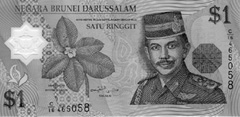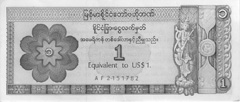
6. money
Southeast Asia is a cheap place, and if you don't need a lot of excesses you should generally be able to get by on under $15 per day, even less if you're dedicated. My trip in fall '98/spring '99 averaged almost exactly $12 per day, and this factors in a month in more expensive West Africa. This covers ALL expenses (except airfare), from the day I left the US, including food, accommodation, transport, visas, post, entrance fees (parks, museums, temples, etc.), baksheesh and the occasional splurge on diversions such as books and movies. The fact is, I wasn't living like a pauper, but I wasn't traveling like a king either. For example, I almost always drank water instead of sodas, and always stayed in a dorm if possible. If you follow the guidelines in this book 95% of the time, you can do it too.
If you're a total ascetic you can get by on even less. Keep in mind that if you're not buying books, going to museums, or sampling the local desserts, then you aren't learning everything there is to know about the countries you pass through. The following is a rough guide to how cheap certain places can be on average if all you do is eat, sleep and travel:
- Trekking in Nepal $3/day
- Laos, Burma, India, rest of Nepal $6/day
- Bangladesh $7/day
- Cambodia, Thailand, Malaysia $9/day
- Brunei, Singapore, Ghana $10/day
- French West Africa $13/day
- Mexico $20/day
- USA $30/day
These amounts can actually drop by $1-2/day in Asia (more elsewhere) if you travel slowly (reducing per diem transport costs) and split rooms with other travelers, and can be much lower if you stay with local families, eliminating accommodation and some food costs.
A key factor in helping to reduce your costs is your whole attitude towards money. To try and live like the locals, you need to think in terms of the local currency whenever making financial transactions. If youíre in India and a taxi driver offers you a ride to your guest house for "only fifty rupees!", donít think to yourself "oh my God, thatís only a dollar twenty!", but rather you should realize thatís a complete rip-off because 50 rupees can get you five taxi rides. Short-term tourists tend to spoil things for the long-term traveler since they will pay outrageous prices for everything, knowing that they will be back at the desk in New York in just a week. If you come across a situation where you know youíre being charged the "white manís fare", just tell the man that youíre a poor student and that youíre well aware of the real price, and heíll almost always smile and tell you to hop on board for a more acceptable fare.
This issue is especially important when youíre staying with locals. DO NOT flaunt your money around anybody, because this gives the impression that you are belittling everyoneís financial situation. If youíre talking with a Cambodian woman and she tells you how sad she is because she cannot pay the 20,000 riel ($5) to visit her husband at his logging camp, express your deep sympathies because you know that bi moen riel is a lot of money. This is where learning numbers in the language can help (see 14. attitude). Just thinking "bi moen riel" in my mind makes me feel like itís a lot of money. To help me with this, I always try to think of the most commonly exchanged bill or coin as what the locals would consider to have the value that one dollar has to me, since a one dollar bill is the most commonly exchanged bill in the US. The following is my rough guide:
Country Common Bill (Think of as $1) In reality
Cambodia 500 riel $0.13
Burma 50 kyat $0.15
Laos 1000 kip $0.16
Bangladesh 10 taka $0.21
India 10 rupees $0.24
Malaysia 1 ringgit $0.26
Thailand 10 baht $0.27
Nepal 20 rupees $0.30
Ghana 1000 cedis $0.43
Brunei, Singapore 1 dollar $0.59
French West Africa 500 francs $0.93
Think of it like this: in the US you can find a cheap meal for $2-3 if you try. In these countries, you can find a cheap meal for 2-3 of these units if you try. This is, in a sense, a rough parallel to the cheapness list earlier in this chapter.

The mighty Brunei dollar.
How to access the money you plan on spending is something that deserves a lot of careful attention. When planning you need to consider safety and ease of exchange. Exchange would be easiest if you could carry everything in small denomination US dollars cash, but this is neither safe nor practical. Travelerís checks are a good idea because they can be replaced if lost or stolen, but they often fetch a lower exchange, have extra fees, or are simply impossible to change in backwater places like rural Indochina or Burma. ATMs and credit cards are maybe the safest way to access money, and they give you good exchange rates, but you can only count on this in modern places like Bangkok, Malaysia, Singapore and Brunei. Your home bank may also charge high fees for international withdrawals. In the mountains of Nepal, if you have anything other than a huge wad of small denomination Nepal rupees, you'll be screwed.
I'd suggest that you try a mix of things. Leave about half of your money in your bank account at home, and simply access it as Thai baht at an ATM when you pass through Bangkok. Withdraw $100-200 worth of baht at a time so you reduce the effects of transaction fees. You'll need lots of cash when you go to Indochina and Burma anyway. Thai baht are just as good as US dollars in Cambodia and Laos. In Burma and Vietnam US dollars are best. Carry the rest in travelerís checks (American Express is the most widely accepted), and always have an emergency stash of US$50-100 cash, in small denominations (no larger than $20), in case of emergencies. Keep your stash well hidden (sole of your shoe, sewn into your clothing or backpack, etc.), since it will save you if absolutely everything else is stolen. In general it's not true that large denominations fetch a better exchange rate than smaller ones when dealing with streetside money changers (see below).
Changing money at the going rate is generally straightforward at banks in Thailand, Malaysia, Singapore, Brunei, India, Bangladesh and Nepal. About the only thing you need to worry about is how to optimize transaction fee losses against carrying too much money. However, in Cambodia, Laos and Burma it pays to use some common sense. Always ask other travelers what the current exchange rate is before you change money. In Cambodia, money carts with lots of riel and photocopied US dollars taped around it tend to congregate on street corners near the market. Every town has money changers, and they all offer the going rate, so you needn't worry about changing everything in Phnom Penh or Siem Reap, for example. They all deal with Thai baht, US dollars and riel interchangeably, since all three are essentially legal currency. These people are generally quite honest, but you shouldn't hesitate to demand a higher rate than quoted if the market rate is not given to you up front. You can always go somewhere else. Banks in Phnom Penh and Siem Reap will cash travelers checks into US dollars cash at 2% commission, and will change US dollars into riel for horrible rates. Change to riel on the street.
In Laos, the game is much trickier. Money changing is illegal, so they're not as forward as in Cambodia. If you're white and walk around the market (talaat sao) in Vientiane or Luang Prabang, you'll be approached by ladies carrying large bags of money. Again, you need to haggle for a higher rate than they offer, but be confident that they are honest and will carry through, as long as you do. Thai baht and US dollars are accepted. Outside of the big cities, changing can be difficult if not impossible, and you will certainly not get a good rate. Banks in Vientiane and Luang Prabang will change travelerís checks into US dollars, and will offer a poorer rate for dollars to kip than on the street.
Burma is a tough one to deal with because of the mandatory exchange of US$300 into Foreign Exchange Certificates (FECs) upon arrival at Yangon Airport. Contrary to popular belief, it's not the end of the world if you have to do this, if you don't succeed in bribing the exchange officer, or if you donít manage to sneak through via the toilets (yes, itís all been done). FECs are the required form of payment for foreigners in guest houses and museums, and they can be changed back into US dollars on the black market, if need be at the end of your trip, for a small loss (perhaps 5%). To get kyat, the local currency, first arrange for a $1 taxi ride to your guest house. When you get comfortable, walk around downtown near the Sulu Paya where you will be approached by moneychangers with calculators. Some guest houses may also change money (hush hush). As in Cambodia and Laos, demand the going rate and these guys will happily change FECs or US dollars into kyat at a rate significantly higher than (50x) the bank rate. You need kyat for all of your other expenses like food and transport. You'll get the best rate in Yangon, so change about half of your 300 FECs into kyat before you head up country. You can change FECs into kyat anywhere in the country, since they are legal tender, but be careful with your US dollars -- they may be difficult to change because locals are not allowed to have any more than 3 US dollars cash. Government officials or other travelers will always know how to change US dollars cash into FECs should you ever run out. If you play your cards right, the 300 dollars should last you for your entire four week visa.

Myanmar funny money (FEC).
If you donít want to change $300 at Yangon Airport because you like to whine and groan about human rights abuses in Burma, the time to make your voice heard is back home, not in country. The Burmese government is not unknown to imprison foreigners, and sentences of a few months to years are dealt out regularly. When in Burma, you are subject to Burmese rules, not those of your home country.
Keep your bank cards and travelerís checks separate from your cash in case one or the other gets lost or stolen. Keep your cash, passport, plane tickets and serial numbers and telephone numbers for your checks and cards in a money belt that fits inside your clothing. Always carry some small cash in your pocket so you don't have to be conspicuously reaching into your secret stash all the time.
In practice you'll probably learn that SE Asia is much safer than your hometown, so you'll make adjustments as you go. For example, I rarely carried my money belt on me. I usually left it at the guest house, in my room, under the mattress or wrapped up in dirty clothing. I felt that the chances of my room being burglarized were even less than getting held up on the street. Obviously, donít do this if youíre staying in a dorm room.